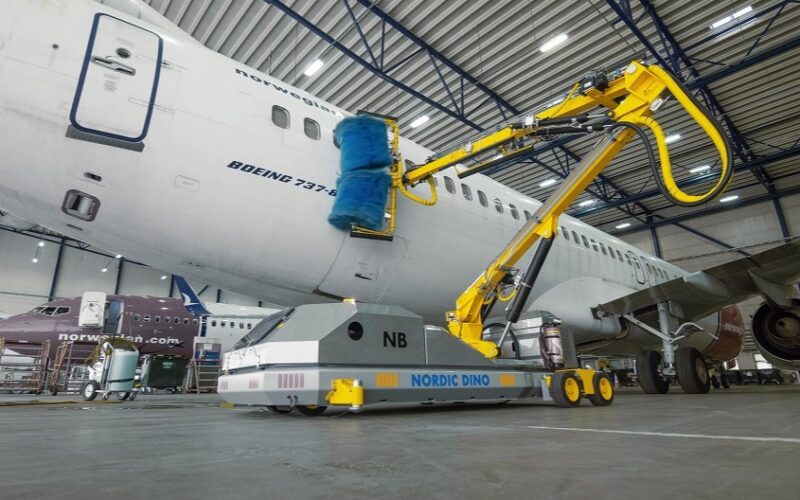In today’s environmentally-conscious world, the aviation industry faces a critical challenge. While air travel connects people and drives economic growth, it also significantly contributes to pollution through aircraft emissions. While many focus on improving engine efficiency and using cleaner fuels, there’s a quieter, yet essential, aspect – the cleanliness of the aircraft’s outside. Neglected by many, a clean exterior plays a big role in the aviation industry’s sustainability goals.
CEO of Nordic Dino Robotics AB, Jo Alex Tanem, explores the connection between clean aircraft exteriors and green initiatives. How cleanliness fits into sustainability, and how advanced cleaning robots are helping airlines meet eco-friendly regulations.
Environmental consequences of dirty aircraft exteriors
The repercussions of neglecting the cleanliness of aircraft exteriors are more profound than what meets the eye. Beyond the surface-level appearance concerns, dirt and grime on aircraft exteriors can lead to a host of environmental problems. First and foremost, the negative impact on the aerodynamics of the aircraft is a significant concern. “When an aircraft’s exterior is marred by dirt, dust, and other contaminants, it disrupts the smooth flow of air over its surfaces. This disruption increases aerodynamic drag, causing the aircraft to require more thrust and fuel to maintain its desired speed and altitude. The consequence of this increased drag is a substantial rise in fuel consumption. With aviation being a major contributor to greenhouse gas emissions, the excessive fuel consumption resulting from dirty exteriors directly worsens the industry’s environmental footprint”, says Jo Alex.
Furthermore, the environmental consequences extend beyond increased fuel consumption. As airlines are striving to meet stringent emissions regulations, any inefficiency in aircraft operations becomes a significant concern. “Dirty aircraft exteriors not only lead to higher emissions but also contribute to a notable increase in air pollution. The accumulated dirt and grime often contain hazardous substances and particulate matter that, when released into the atmosphere, can harm air quality and public health. This pollution can have far-reaching consequences, particularly in and around airports and heavily travelled flight paths”, explains CEO of Nordic Dino Robotics AB.
Clean exteriors not only enhance an airline’s operational efficiency by reducing fuel consumption but also align with the industry’s overarching goals of minimizing its environmental impact.
How clean aircraft exteriors align with industry sustainability goals
In recent years, the aviation industry has experienced a notable shift towards sustainability, driven by growing awareness of its environmental impact and the need to address climate change. This shift encompasses a wide range of initiatives, from developing more fuel-efficient aircraft to exploring sustainable aviation fuels. However, one often overlooked aspect of this transformation is the role that cleanliness of aircraft exteriors plays in achieving sustainability goals.
“Cleanliness of aircraft exteriors is not merely a matter of aesthetics; it directly impacts the industry’s ability to reduce emissions and fuel consumption. Several pioneering airlines and organizations are leading by example in championing the cleanliness of aircraft exteriors as a sustainability imperative. These forward-thinking entities recognize that investing in exterior cleanliness is an investment in a greener future. Some airlines have already implemented rigorous aircraft cleaning protocols and adopted innovative technologies to ensure their fleets remain as clean as possible. Additionally, aviation industry associations, including the International Air Transport Association (IATA), are actively promoting the importance of clean exteriors in achieving sustainability objectives, advocating for industry-wide best practices”, says Jo Alex.
According to the CEO of Nordic Dino Robotics AB, by prioritizing the cleanliness of their aircraft exteriors, airlines not only demonstrate their commitment to sustainability but also take concrete steps towards a cleaner and more environmentally friendly aviation future.
The role of cleaning robots in meeting sustainability regulations
Cleaning robots represent a cutting-edge solution with transformative potential in the aviation industry’s quest for sustainability. These advanced machines, equipped with innovative technology, have emerged as a game-changer in the pursuit of cleaner aircraft exteriors. They signify a departure from traditional manual cleaning methods and introduce automation into the maintenance process, offering a more efficient and environmentally friendly approach.
“First of all, cleaning robots operate with precision and efficiency. Equipped with a range of sensors and cameras, they can assess the condition of an aircraft’s exterior in real-time, identifying areas that require attention. These robots are designed to perform cleaning tasks with minimal water usage and environmentally friendly cleaning agents, minimizing the environmental footprint associated with cleaning operations. Their automation ensures consistent and thorough cleaning, leaving no room for oversight or error”, explains Jo Alex.
The cost-effectiveness and long-term benefits of using cleaning robots are compelling. While the initial investment in these machines may seem substantial, their efficiency, reduced labor costs, and fuel savings quickly lead to significant cost reductions. “The extended lifespan of aircraft exteriors resulting from consistent, thorough cleaning translates into substantial maintenance savings in the long run. Beyond financial gains, the environmental benefits, such as lower emissions and decreased water usage, position cleaning robots as a sustainable choice for airlines aiming to meet stringent environmental regulations. Incorporating cleaning robots into aircraft maintenance not only enhances efficiency and cleanliness but also reinforces the aviation industry’s commitment to sustainability”, says Jo Alex.

